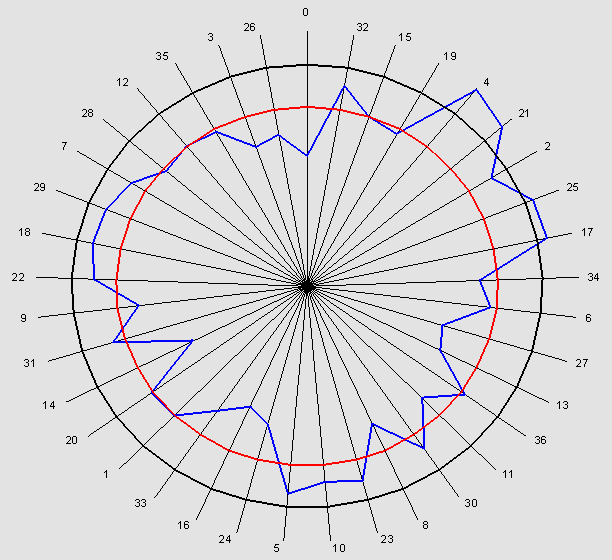
On page 52 Martin Blakey wrote:
I do not believe that there are any biased wheels in use in any Australian or UK casino. It would be against the casino's interest to allow any bias since an aware player could take advantage of such a situation.On page 53 he listed the spins (actually 39,998) he had clocked on one wheel. He added this comment:
Comparing the actual results to the theoretical, it can be seen that there is a strong correlation.
My examination of Blakey's spins puts a quite different slant on things. A chi-squared test indicated the wheel was biased. An Excel chart of the wheel, in pocket order, shows where the bias was located. The chart minimum has been set to make the spins easier to see.

Surprisingly, Blakey, a mathematician, failed to notice this bias or its location in a sector of the wheel. The four biased numbers with excess spins are easy to see because they are grouped, but there are also four biased numbers, 0, 14, 16 and 27, with abnormally low spins.
Almost a quarter of the numbers (8 out of 37) are biased, yet Blakey says "it can be seen that there is a strong correlation" with the theoretical. That is wrong! If Blakey were right these 40,000 spins would be much more evenly distributed.
Winning systems are impossible to devise for negative expectation games, such as roulette. However, if a wheel was biased to the extent that some numbers had a positive expectation of winning, then it would be possible to devise a winning system for that particular wheel. Blakey believed there were no biased wheels but then unwittingly worked out his system from biased results. It is no surprise that he was able to back-fit it to work for THAT biased wheel but impossible it could work on unbiased wheels.
Two players from Launceston, J and D, his son-in-law(?) often travelled to Hobart to play Martin Blakey's system. I was introduced to them and they explained it all to me, but I just listened and never mentioned the bias. They kept on losing and losing. To try to stem their losses they met with Blakey. He modified his system but, despite these refinements, they gave up after a few months.
Blakey's comment "I do not believe that there are any biased wheels in use" proved ill-judged. In the early 90s, Hobart casino was hit by biased wheel players. The result: roulette virtually closed down for a time, with a $10 MAXIMUM bet on a number, believe it or not. All wheels in Hobart and Launceston were soon replaced with Huxley Mk. 6 adjustable wheels.